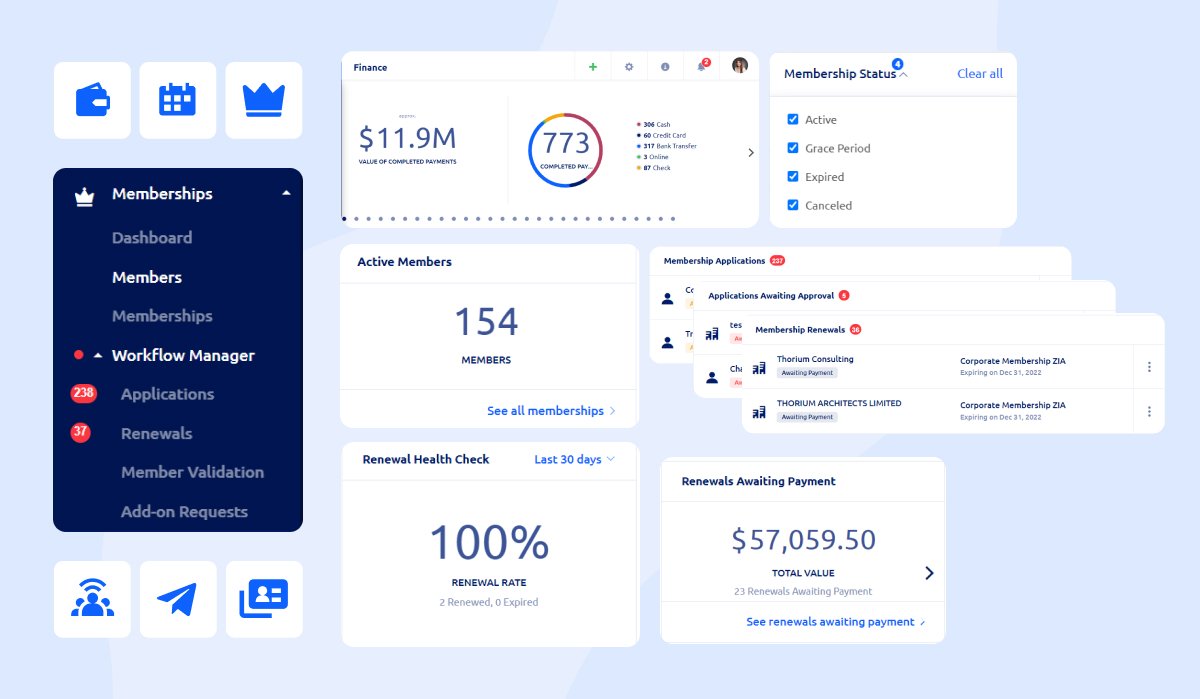
Last Updated: March 1, 2024
Developing digital transformation strategies is vital to help businesses maximize customer experience and achieve their digitalization goals. They realign the entire business infrastructure, incorporate valuable initiatives, and prioritize results-driven technologies.
However, the concept of digitalization may seem different for different departments. From a technological perspective, it typically means incorporating technologies that automate, reduce cost, and save time. From the UX standpoint, it involves improving customers’ experience through product innovation. In contrast, the management team views it as an opportunity to reshape the organization's culture. Thus, transformation strategies vary greatly depending on what fields an organization includes.
In this article, we will explore the five main components of constructing an effective digitalization strategy for a membership organization. We will also highlight the top ten strategies to help you move forward in your transformation journey while providing a premium experience to your members.
So let’s get started.
Key Takeaways
- Digital transformation is essential for businesses to maximize customer experience and achieve digitalization goals. It emphasizes the importance of a holistic approach to adopting digital solutions.
- Digitalization is perceived differently across various departments within an organization. Technological integration, enhancing customer experience, and reshaping organizational culture are all facets of digital transformation.
- An effective digital transformation strategy involves five main components, including a clear roadmap, a culture of innovation, data analysis, selecting the right technologies, and measuring outcomes to ensure the success of digital transformation efforts.
- A robust digital transformation strategy helps organizations stay competitive, increase efficiency, enhance customer experience, drive data-driven innovation, and maintain adaptability and resilience in the face of changing digital landscapes.
- Glue Up is highlighted as a transformative platform for membership organizations, offering a centralized CRM and modules that automate membership management processes, enable networking among members through a private community app, and provide analytics for immediate insights into member activities.
What Is a Digital Transformation Strategy?

A digital transformation strategy includes incorporating digital technologies across all facets of an organization to promote better efficiency and collaboration as well as deliver a top-notch experience to the customers.
The objective of an effective digitalization strategy is to understand the current situation, the goals, and how to move forward on the transformational journey in a way that makes sense.
A digital transformation does not only involve integrating technology but may call for a complete re-invention of the organization model. From day-to-day procedures to the major organizational hierarchy, digitalization may demand change at every single level of the culture.
Additionally, a business transformation strategy should not be restricted to near-term goals. Rather, it should take a long-term view of how organizations will compete in the digital economy in the future. To do that, it is essential to understand the core values, strengths, weaknesses, and competitive landscape of the business.
Why Is Developing a Digital Transformation Strategy Important?
Adopting digital transformation without a clear strategy is similar to navigating without a map.
It's as if you aspire to achieve digital transformation but lack a roadmap or understanding of how to proceed. Thus, having a robust strategy stands as the first and foremost step in any project, including digital transformation.
The statistics suggest that 70 percent of companies either have a digital transformation strategy in place or are working on one showcasing the importance of digital transformation strategy.
Besides, a well-defined strategy is a must for several reasons, and its absence can lead to misdirection.
Here's why having a strategy is mandatory for digital transformation:
Staying Competitive
A robust strategy enables you to keep pace with or even overtake your competitors. It involves observing and analyzing the technologies adopted by competitors. With a clear strategy, you can ensure that your technology is at par or more advanced than theirs but never inferior. This competitive edge is only achievable with a clear and proactive strategy.
Increased Efficiency
A well-crafted strategy enhances efficiency by saving time and reducing costs. It allows for the streamlining of processes and the elimination of redundancies, making the journey towards digital transformation more direct and less wasteful.
Enhanced Customer Experience
The strategy ensures that the transition toward digital transformation is executed in phases rather than all at once. This phased approach allows for continuous analysis and improvement of how services and products are delivered, ensuring that customer experiences are consistently enhanced and tailored to meet evolving needs.
Data-Driven Innovation
A strategic approach to digital transformation advocates for a data-driven methodology. This means decisions are informed by data—numbers, performance metrics, and statistics. Such an approach simplifies the technology selection process, making it easier to determine which technologies will perform better, which are likely to encounter challenges, and where the greatest opportunities for innovation lie.
Adaptability and Resilience
Finally, having a strategy in place promotes adaptability and resilience. It prepares organizations to respond to changes and challenges in the digital age with agility. A strategic approach equips businesses to remain robust despite evolving market demands and technological advancements.
Who Should Be Involved When Creating a Digital Transformation Strategy?
Initiating a digital transformation strategy requires the inclusion of all key stakeholders to guarantee comprehensive information sharing and involvement, ensuring that initiatives proceed as planned.
Moreover, engaging stakeholders promotes transparency and lays the foundation for the successful transformation of the digitalization strategy. Thus, it is crucial to involve the following stakeholders:
- Executive Leadership (C-Suite): Executives like the CEO, CTO, CIO, CMO, and CDO provide vision and support crucial for aligning the digital transformation strategy with the organization's strategic goals. Notably, CIOs are most often reported as owning or sponsoring digital transformation initiatives (28%), with CEOs increasingly playing a leadership role (23%). Additionally, companies with an engaged Chief Digital Officer (CDO) are likely to report 1.6 times more successful digital transformation outcomes.
- IT Department: The IT Department is responsible for the technical implementation; they ensure the technology aligns with business needs.
- Operations Management: They provide insights on process improvements and how digital tools can enhance operational efficiency.
- Marketing and Sales Teams: These stakeholders understand customer needs and can help tailor the digital transformation strategy to improve customer experience.
- Human Resources: HR plays a vital role in managing change, addressing concerns, and helping staff adapt to new technologies and processes.
- Finance Department: Their involvement ensures the digital transformation strategy is financially viable and aligns with budgetary constraints.
- Customer Representatives: Including the voice of the customer ensures the transformation meets their needs and expectations.
- External Partners and Vendors: They can offer valuable perspectives on technology trends and how external processes might integrate with your digital transformation strategy efforts.
Digital Transformation Strategy – 5 Key Components
Effective digital transformation requires planning, expertise, and a radical approach to traditional business practices. As a result, there are five essential components that must be considered when developing a strategy, which includes:
1- Effective Roadmap With Relevant Strategies

While a basic strategy linked to the right technologies can help you digitalize your business, it requires the right mindset guidance to achieve successful transformation. In order to be successful, your association needs a well-designed digital transformation roadmap with relevant strategies.
The roadmap identifies the pain points and offers suggestions on how to overcome them. Based on that, the appropriate strategies define the steps you need to take to digitally transform your business.
2- Culture of Innovation and Experimentation
A culture shift is quintessential for every organization seeking digitalization.
For digital business transformation, an innovative culture is defined as an environment that fosters creative thinking and experimenting for better economic and social performance. It also includes using advanced systems and automated systems like chatbots, AI, big data, and machine learning to facilitate digital disruption at work.
Considering the fierce competition in the market, the only choice is to adapt to the dynamic environment or fail. It also means that an organization must be comfortable with failing and experimenting to foster an adaptive culture.
3- Data Analysis

Analysis and integration of data could help you find the best solutions to problems, thus resulting in an improved digital business transformation strategy and making the most of the transformation process.
A digitalization strategy identifies the appropriate tools and KPIs to measure the data, works on the right management and processing, and performs analytics periodically to support intelligently informed decisions across the organizational processes.
4- Right Technologies
When drafting an IT transformation strategy, one of the most critical steps is identifying the right technologies for your business. Whether you are upgrading your processes, revamping applications, or creating an entirely new digital system, finding the right technology is imperative for a successful outcome.
Since this step requires substantial financial investment, make sure you select the right technologies that meet your business goals. The right way to select technology is to consider your budget and then consider the best options that are available.
Some of the best digital transformation technologies for member-based organizations include cloud platforms, digital twins, machine learning, and artificial intelligence.
5- Results to Measure the Success of Digital Transformation Strategies

A successful digital transformation strategy relies on agility. You need to follow the detailed strategy you have developed but keep an open mind for changes if things do not go as planned.
Depending on the technologies and practices you employ, you will always obtain different results. Plan long-term strategies that take initial results into account and scale the digital transformation as your business grows while also meeting new objectives along the way.
If necessary, your team must be able to adapt to the results and make changes.
Member-Based Organizations: 10 Strategies for Accelerating Their Digital Transformation Journey
If you are looking for effective ways to level up your organization digitally, here are some of the top business transformation strategies you should consider:
1. Invest in Effective Digital Technologies in Demand

Investing in the right digital technologies is imperative as it will help you attract new members as well as retain your current ones. As a membership organization, you should choose technologies that save time while providing a premium experience to your members.
You can use a single, hybrid, or a combination of more technologies when making strategies for your business. For example, augmented reality can enhance the attendees' experience during events by showing the visitors a virtual walk-through based on the previous event footage. Similarly, the combination of robotics with AI and IoT can improve user experience, boost efficiency, and improve productivity tenfold.
Thus, effective technologies can assist your organization in making better decisions, strengthening your business relationships, and preparing for the future.
Additionally, you should invest in the following tools to improve your digital transformation strategies.
- Project management tools - To improve coordination and productivity among your team members.
- Time-tracking tools - Managing efficiencies of the tasks
- Social media management tools - Create and automate social media marketing as well as aid in data analytics.
- HR platforms - Automate and manage HR tasks like recruitment, payroll, performance tracking, and benefits administration.
2. Increase Funding for Technological Research and Development

Investing in technologies without exploration and feedback can be detrimental to the business’s overall well-being.
Research and development help processes to be optimized to their full potential. They mark the failed procedures while making discoveries and innovations in the process.
Thus, increasing the budget for technological research and development is essential when creating strategies for your business transformation.
As well as creating new products and improving existing ones, R&D also helps organizations improve their marketing strategies and create cost reduction plans.
3. Hire Technologically Proficient People
New digital infrastructure requires recruiting new staff members as well as upskilling existing ones. You can create training programs for existing employees for performing job-related tasks. However, it’s best to hire expert staff for software-related skills as training existing employees may take a long-time.
Scouting for the right talents in the competitive IT fields such as dev-ops and UX may seem difficult. However, you may leverage platforms like LinkedIn to find the right potential.
The digital revolution enables flexibility in all business processes, including hiring. With the joint efforts of the HR and technological teams, you can take advantage of this digital flexibility in recruiting the right candidates.
4. Improve Business Digital Systems With Data Analytics
It is evident that digitalization is not possible without data analysis. Big data analytics can help organizations discover patterns and observe trends. This data, combined with artificial intelligence can accelerate digitalization.
Several cloud platforms provide data analytics to membership organizations. For instance, Glue-Up offers data analytics members’ activities from events, email marketing, finance, and more to make informed decisions.
5. Attend Seminars and Conferences to Learn From Other Businesses

Digital transformation involves a lot of experimenting and testing. But what approaches and technologies should be employed to minimize failures?
A smart way to do this is to learn from other businesses, including competitors. By closely observing their activities, products, and customers, you can gain an understanding of what works the best and what practices should be avoided. Similarly, seminars and conferences can keep you up-to-date on the latest technological trends and initiatives to propel your business forward.
These events also provide opportunities to strengthen your professional network. The business personalities can guide you in your journey by giving you insight on how to improve your operations and culture.
6. Develop an Effective Training System for Upskilling Employees

As mentioned earlier, digital transformation requires a culture of continuous learning and innovation. It also involves implementing new software and tools, which requires staff to be upskilled.
Training cultures can be fostered by a variety of platforms and techniques. To guide newcomers, a training website featuring written lectures and recorded webinars should be made available. Additionally, you can arrange hybrid meetings to bring all the tech leaders in one meeting to give comprehensive training to your employees.
You can also use AI to create a personalized learning path for each employee based on their capabilities, understanding, and intelligence. For instance, some employees might receive video tutorials through the LMS like iSpring Learn, while others may get text-based articles, depending on their learning preferences.
7. Performing A/B Tests for Processes and Technologies

Digital transformation is all about experimentation. You cannot move forward without testing new technologies with the business requirements of your organization.
The smartest way to experiment is to conduct A/B testing for the same technology or process. This not only adds process transparency but also saves you time by giving faster results. You can also mark errors or failed KPIs during the testing.
For member-based organizations, A/B testing can be done to improve the user interface, automation systems, or the membership types and figure out which one works the best.
8. Hire Digital Transformation Consultants
Many organizations hire digital transformation consultants to help them with their digitalization process. The benefits of consulting experts include maximizing results at minimal risk and saving time.
Digital transformation consultants identify the pain points in your business, evaluate your goals and budget, and create concise plans for you to implement. As they are experts in strategy, the chances of their strategies failing are minimal.
If you are not yet ready to build a digitalization roadmap yourself, hiring digital transformation consultants can be a good option.
9. Make Improvements in Accordance With the Members’ Needs

A successful membership organization considers the needs of its members and keeps updating its processes accordingly. In addition to helping them boost their current members' standards, it also helps them attract new ones through PR and positive reviews.
Collecting open-ended surveys and feedback via emails is a great way to gather your customers’ needs. However, you can also engage them through monthly meetings (in-person or online).
In such cases, RTC platforms like Spark might help you a great deal in conducting meaningful discussions. You can ask them questions like how is their overall experience? What they would like to improve or change? And what technologies they think could improve organizational performances.
You can also feed all the information into an AI platform to generate better suggestions based on the data analysis.
10. Select the Right Digital Transformation Platform

Digital tools that enable businesses to improve their competitive position with innovation and smart solutions are called digital transformation platforms. These platforms combine various technologies into one system to accomplish a specific goal.
Choosing the right digitalization platform is as important as planning the transformation itself. While the right tool can set you apart, choosing the wrong one can lead to serious financial and strategic consequences.
How to Measure the Success of a Digital Transformation Strategy
Measuring the success of a digital transformation strategy involves assessing various key performance indicators (KPIs) and metrics that align with your organization's goals and objectives.
Here's a comprehensive approach to evaluating the effectiveness of a digital transformation strategy:
Customer Experience and Engagement
- Customer Satisfaction Scores (CSAT): Measure customer satisfaction before and after the implementation of the digital transformation roadmap.
- Net Promoter Score (NPS): Assess the likelihood of customers recommending your services/products to others.
- Customer Engagement Metrics: Gauge customer engagement through digital channels, including website visits, app usage, and social media interaction.
Operational Efficiency
- Process Efficiency Improvements: Assess the reduction in process times, error rates, and operational challenges.
- Cost Reduction: Measure cost savings resulting from digital processes, such as reduced manual labor and lower operational expenses.
- Automation Rate: The percentage of automated processes can be a key indicator of digital transformation progress.
Innovation and Agility
- Time to Market: Monitor how quickly new products or features are launched before and after digital transformation.
- Product Innovation Rate: Track the number of new products or services developed as a result of digital initiatives.
Employee Productivity and Engagement
- Employee Productivity Metrics: Analyze productivity changes by measuring output per employee or team before and after digital interventions.
- Employee Engagement Scores: Use surveys to analyze how digital tools and processes have impacted employee satisfaction and engagement.
Financial Performance
- Revenue Growth: Monitor changes in revenue, especially from digital channels or products.
- Return on Investment (ROI): Calculate the ROI of digital transformation technologies by comparing the benefits (cost savings, increased revenue) against the costs.
- Profit Margins: Assess improvements in profit margins as a result of operational efficiencies and revenue growth.
Data and Analytics Maturity
- Data Utilization: Evaluate how effectively data is being used for decision-making.
- Analytics Adoption: Measure the extent to which analytics and business intelligence tools are integrated into business processes.
Technology Infrastructure and Scalability
- System Performance Metrics: Track the reliability, speed, and uptime of digital systems.
- Scalability: Calculate how well your digital infrastructure can accommodate growth without significant additional costs.
Security and Compliance
- Security Incidents: Track the number and severity of security incidents before and after transformation.
- Compliance Rates: Ensure that digital solutions comply with relevant regulations and industry standards.
Feedback Loops and Continuous Improvement
Implement mechanisms to gather continuous feedback from customers, employees, and other stakeholders.
Use this feedback to iterate and improve digital initiatives, demonstrating a commitment to continuous improvement.
What Are the Key Trends for Digital Transformation?
The trends in digital transformation are not static; instead, they continuously evolve as technology advances. What might have been considered a cutting-edge trend at one point can quickly become outdated, underscoring the dynamic nature of digital transformation.
This process is similar to regular exercise: consistent effort is required to stay "fit" and competitive.
If you neglect it, you risk falling behind. However, recent trends in digital transformation suggest that they are likely to stay in for some time.
Here are the key trends currently shaping digital transformation:
1. Artificial Intelligence (AI) and Machine Learning (ML)
The AI boom has swept through industries and businesses worldwide, marking its presence everywhere.
Although the role of AI in digital transformation is not a new concept, its rapid evolution, especially in the domain of machine learning, has positioned it as a key force in transforming industries.
Leading the charge, sectors such as healthcare, finance, retail, manufacturing, and transportation have witnessed revolutionary changes thanks to AI integration.
Machine learning enables systems to learn from data, improve from experience, and predict outcomes without being explicitly programmed. This capability is fundamental to the development of intelligent systems that can perform complex tasks, from voice recognition in customer service applications to real-time recommendations in e-commerce.
Businesses across the spectrum are eager to integrate AI and machine learning technologies to minimize human dependency as much as possible. Consequently, there's a significant surge in investment toward these technologies as key components of digital transformation.
Statistics indicate that by 2025, AI and machine learning technology will be inserted in the processes and products of at least 90% of new enterprise applications, signaling a transformative shift in how businesses operate and innovate. This integration not only optimizes operations but also unlocks new opportunities for innovation and competitive advantage.
2. Cloud Technology
Businesses across various industries are increasingly recognizing the critical role of cloud technology when it comes to digital transformation. As organizations strive to become more agile, efficient, and innovative, the shift toward cloud services has become a cornerstone strategy.
The economic implications of this shift are substantial. According to statistics, global spending on public cloud services reached around $591.8 billion in 2023. This represents a significant growth rate of 20.7% compared to the previous year, underscoring the accelerating pace at which businesses are migrating to the cloud.
This surge in investment reflects not only the growing confidence in cloud solutions but also the acknowledgment of their strategic importance in achieving long-term technological advancement.
3. More Investment in Digital Transformation
The trend of increasing investment in digital transformation underscores a strategic shift across industries, recognizing the immense value it brings to operational efficiency, customer experience, and competitive positioning.
This rise in investment is driven by the need to adapt to rapidly changing market dynamics, embrace agility, and leverage technological advancements to fuel growth and innovation.
This necessity is reflected in the substantial growth of global investment in digital transformation, which is expected to almost double from $1.8 trillion in 2022 to $2.8 trillion by 2025. This increase highlights the escalating importance placed on digital initiatives as foundational elements of corporate strategy.
Organizations are channeling resources into transforming their operations, products, and services with digital technology at the core, aiming to enhance agility, optimize processes, and create more personalized and engaging customer experiences.
4. Leveraging Digital Technologies for Sustainability Goals
Leveraging top digital transformation platforms for sustainability goals represents a growing trend within digital transformation, where businesses and organizations utilize advanced technologies to address environmental challenges and promote sustainable practices.
This approach encompasses using AI, IoT, blockchain, and big data analytics to optimize resource use, reduce waste, enhance energy efficiency, and minimize carbon footprints. For instance, AI can forecast energy demands more accurately, leading to more efficient energy use, while IoT devices can monitor and manage resource consumption in real-time.
Blockchain technology supports traceability in supply chains, ensuring ethical and sustainable sourcing. This trend reflects a broader shift towards integrating environmental considerations into digital strategies, aligning with global sustainability targets and consumer expectations for eco-friendly practices.
By embedding sustainability into their digital transformation initiatives, companies not only contribute to environmental preservation but also unlock new opportunities for innovation, efficiency, and competitive advantage in the market.

Glue Up, a leading transformation platform for membership organizations, has helped several companies worldwide implement successful digitalization. This cloud software has a centralized CRM that, together with its modules, streamlines your processes, builds your community, and automates your workflows.
On one hand, it helps member-based organizations save time and cost by automating all of their membership management processes. From custom application forms and synchronizing members’ data to managing membership renewals, Glue Up streamlines all the processes through its cutting-edge technology.
On the other hand, it enables networking among your members through its private community app. They can post, create groups, share business cards, and chat one-on-one through this community app. The platform also has an analytics section that provides immediate insights into your member’s activities from events, email marketing, and finance.
Want to learn more about the platform? Click on this link to request a demo.



